Human Resource Management Analysis for SingTel: A Comprehensive Report
VerifiedAdded on 2022/08/21
|17
|5119
|16
Report
AI Summary
This report provides a comprehensive analysis of SingTel's Human Resource Management (HRM) practices. It begins by critically assessing employee engagement strategies, considering both emotional and cognitive engagement methods, and exploring the importance of meaningfulness, safety, and resource availability. The report then examines SingTel's organizational culture and structure, evaluating their impact on employee behavior, considering the influence of clan, adhocracy, market, and hierarchical structures, and the implications of global cultural dimensions. The report further investigates the role of personality and emotions in increasing employee motivation, applying the Big Five personality model. Finally, the report concludes with a critical evaluation of leadership approaches, focusing on the development of future leaders within SingTel, emphasizing the need for effective communication, adaptability, and strategic alignment to enhance organizational performance and foster a positive work environment.
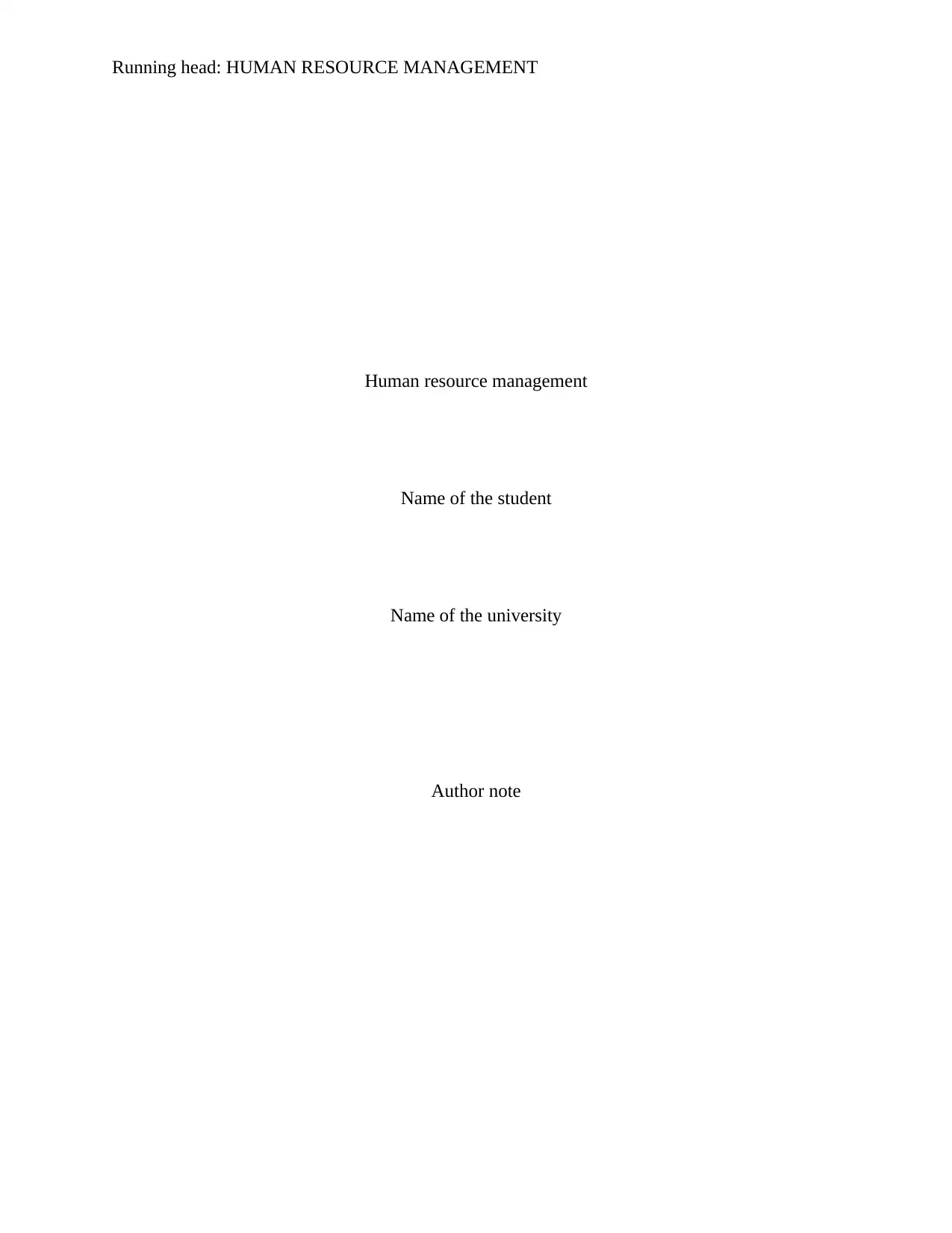
Running head: HUMAN RESOURCE MANAGEMENT
Human resource management
Name of the student
Name of the university
Author note
Human resource management
Name of the student
Name of the university
Author note
Paraphrase This Document
Need a fresh take? Get an instant paraphrase of this document with our AI Paraphraser
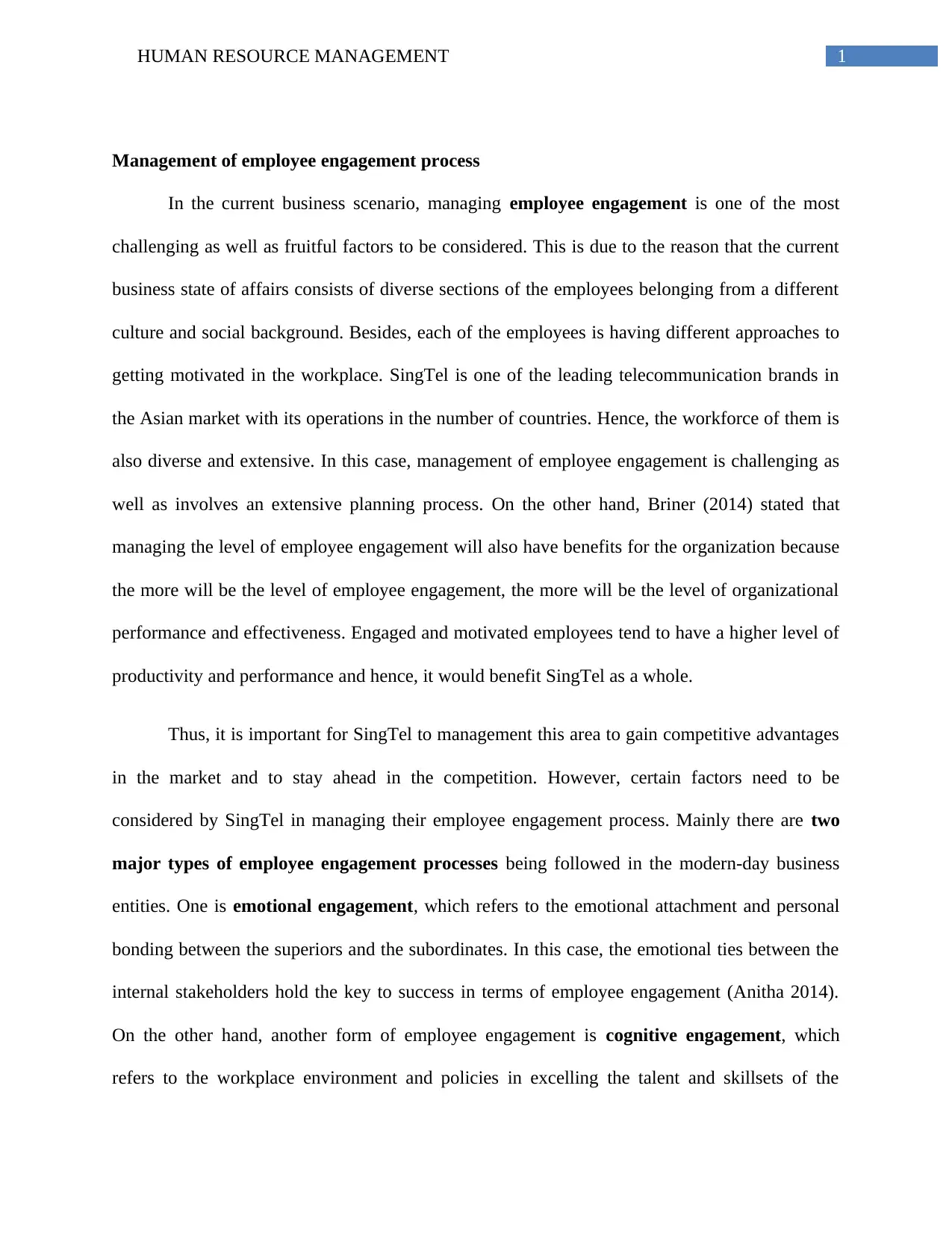
1HUMAN RESOURCE MANAGEMENT
Management of employee engagement process
In the current business scenario, managing employee engagement is one of the most
challenging as well as fruitful factors to be considered. This is due to the reason that the current
business state of affairs consists of diverse sections of the employees belonging from a different
culture and social background. Besides, each of the employees is having different approaches to
getting motivated in the workplace. SingTel is one of the leading telecommunication brands in
the Asian market with its operations in the number of countries. Hence, the workforce of them is
also diverse and extensive. In this case, management of employee engagement is challenging as
well as involves an extensive planning process. On the other hand, Briner (2014) stated that
managing the level of employee engagement will also have benefits for the organization because
the more will be the level of employee engagement, the more will be the level of organizational
performance and effectiveness. Engaged and motivated employees tend to have a higher level of
productivity and performance and hence, it would benefit SingTel as a whole.
Thus, it is important for SingTel to management this area to gain competitive advantages
in the market and to stay ahead in the competition. However, certain factors need to be
considered by SingTel in managing their employee engagement process. Mainly there are two
major types of employee engagement processes being followed in the modern-day business
entities. One is emotional engagement, which refers to the emotional attachment and personal
bonding between the superiors and the subordinates. In this case, the emotional ties between the
internal stakeholders hold the key to success in terms of employee engagement (Anitha 2014).
On the other hand, another form of employee engagement is cognitive engagement, which
refers to the workplace environment and policies in excelling the talent and skillsets of the
Management of employee engagement process
In the current business scenario, managing employee engagement is one of the most
challenging as well as fruitful factors to be considered. This is due to the reason that the current
business state of affairs consists of diverse sections of the employees belonging from a different
culture and social background. Besides, each of the employees is having different approaches to
getting motivated in the workplace. SingTel is one of the leading telecommunication brands in
the Asian market with its operations in the number of countries. Hence, the workforce of them is
also diverse and extensive. In this case, management of employee engagement is challenging as
well as involves an extensive planning process. On the other hand, Briner (2014) stated that
managing the level of employee engagement will also have benefits for the organization because
the more will be the level of employee engagement, the more will be the level of organizational
performance and effectiveness. Engaged and motivated employees tend to have a higher level of
productivity and performance and hence, it would benefit SingTel as a whole.
Thus, it is important for SingTel to management this area to gain competitive advantages
in the market and to stay ahead in the competition. However, certain factors need to be
considered by SingTel in managing their employee engagement process. Mainly there are two
major types of employee engagement processes being followed in the modern-day business
entities. One is emotional engagement, which refers to the emotional attachment and personal
bonding between the superiors and the subordinates. In this case, the emotional ties between the
internal stakeholders hold the key to success in terms of employee engagement (Anitha 2014).
On the other hand, another form of employee engagement is cognitive engagement, which
refers to the workplace environment and policies in excelling the talent and skillsets of the
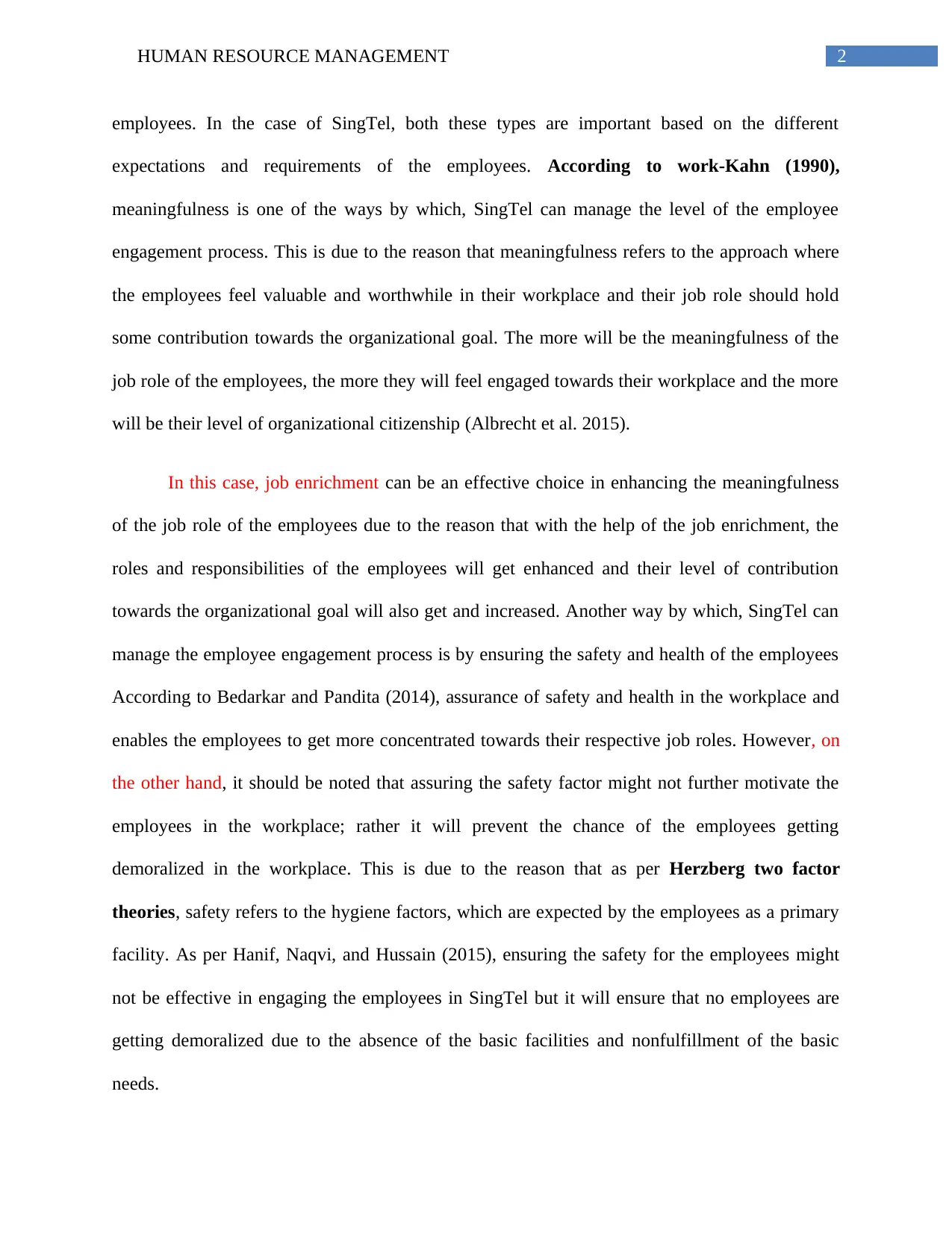
2HUMAN RESOURCE MANAGEMENT
employees. In the case of SingTel, both these types are important based on the different
expectations and requirements of the employees. According to work-Kahn (1990),
meaningfulness is one of the ways by which, SingTel can manage the level of the employee
engagement process. This is due to the reason that meaningfulness refers to the approach where
the employees feel valuable and worthwhile in their workplace and their job role should hold
some contribution towards the organizational goal. The more will be the meaningfulness of the
job role of the employees, the more they will feel engaged towards their workplace and the more
will be their level of organizational citizenship (Albrecht et al. 2015).
In this case, job enrichment can be an effective choice in enhancing the meaningfulness
of the job role of the employees due to the reason that with the help of the job enrichment, the
roles and responsibilities of the employees will get enhanced and their level of contribution
towards the organizational goal will also get and increased. Another way by which, SingTel can
manage the employee engagement process is by ensuring the safety and health of the employees
According to Bedarkar and Pandita (2014), assurance of safety and health in the workplace and
enables the employees to get more concentrated towards their respective job roles. However, on
the other hand, it should be noted that assuring the safety factor might not further motivate the
employees in the workplace; rather it will prevent the chance of the employees getting
demoralized in the workplace. This is due to the reason that as per Herzberg two factor
theories, safety refers to the hygiene factors, which are expected by the employees as a primary
facility. As per Hanif, Naqvi, and Hussain (2015), ensuring the safety for the employees might
not be effective in engaging the employees in SingTel but it will ensure that no employees are
getting demoralized due to the absence of the basic facilities and nonfulfillment of the basic
needs.
employees. In the case of SingTel, both these types are important based on the different
expectations and requirements of the employees. According to work-Kahn (1990),
meaningfulness is one of the ways by which, SingTel can manage the level of the employee
engagement process. This is due to the reason that meaningfulness refers to the approach where
the employees feel valuable and worthwhile in their workplace and their job role should hold
some contribution towards the organizational goal. The more will be the meaningfulness of the
job role of the employees, the more they will feel engaged towards their workplace and the more
will be their level of organizational citizenship (Albrecht et al. 2015).
In this case, job enrichment can be an effective choice in enhancing the meaningfulness
of the job role of the employees due to the reason that with the help of the job enrichment, the
roles and responsibilities of the employees will get enhanced and their level of contribution
towards the organizational goal will also get and increased. Another way by which, SingTel can
manage the employee engagement process is by ensuring the safety and health of the employees
According to Bedarkar and Pandita (2014), assurance of safety and health in the workplace and
enables the employees to get more concentrated towards their respective job roles. However, on
the other hand, it should be noted that assuring the safety factor might not further motivate the
employees in the workplace; rather it will prevent the chance of the employees getting
demoralized in the workplace. This is due to the reason that as per Herzberg two factor
theories, safety refers to the hygiene factors, which are expected by the employees as a primary
facility. As per Hanif, Naqvi, and Hussain (2015), ensuring the safety for the employees might
not be effective in engaging the employees in SingTel but it will ensure that no employees are
getting demoralized due to the absence of the basic facilities and nonfulfillment of the basic
needs.
⊘ This is a preview!⊘
Do you want full access?
Subscribe today to unlock all pages.

Trusted by 1+ million students worldwide
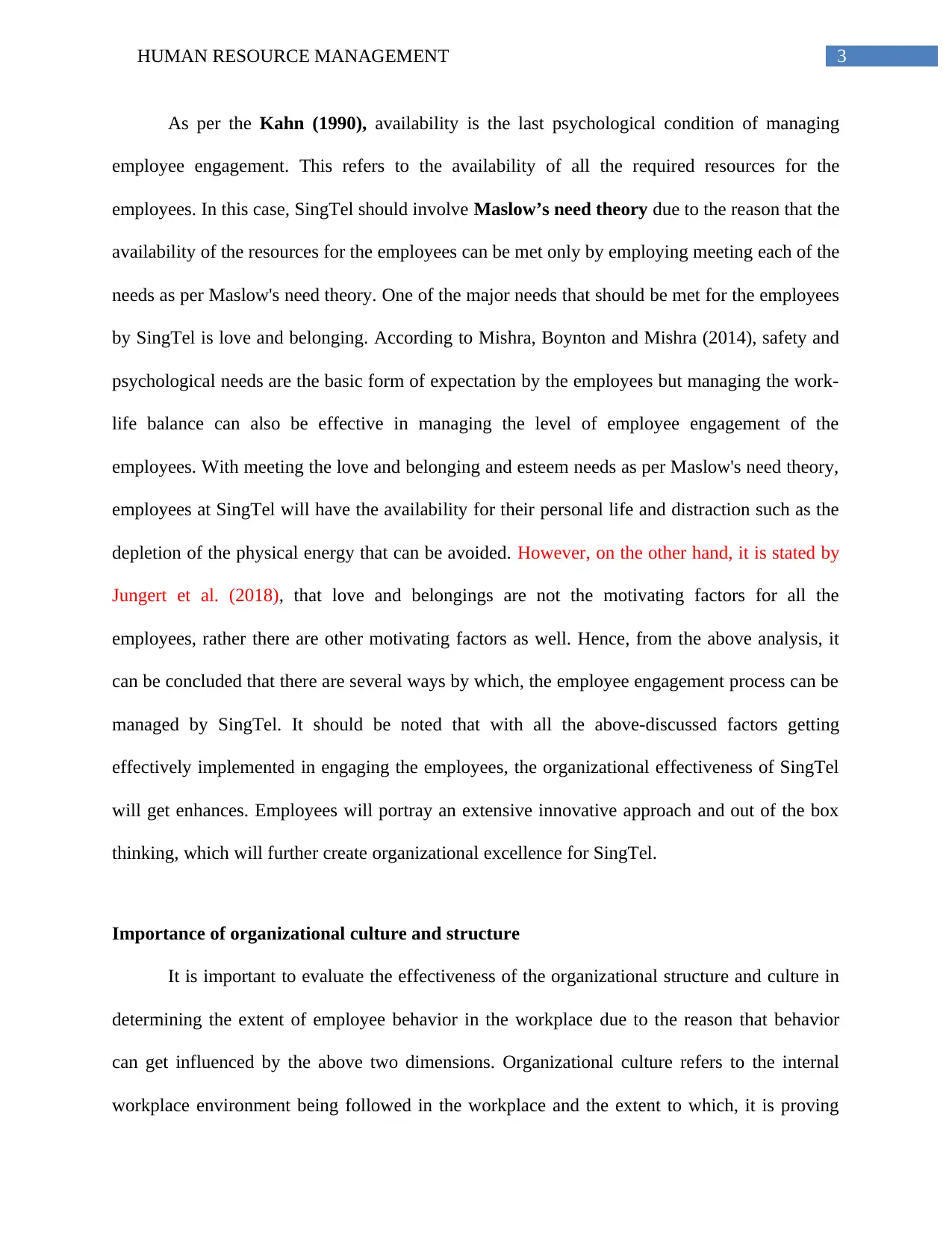
3HUMAN RESOURCE MANAGEMENT
As per the Kahn (1990), availability is the last psychological condition of managing
employee engagement. This refers to the availability of all the required resources for the
employees. In this case, SingTel should involve Maslow’s need theory due to the reason that the
availability of the resources for the employees can be met only by employing meeting each of the
needs as per Maslow's need theory. One of the major needs that should be met for the employees
by SingTel is love and belonging. According to Mishra, Boynton and Mishra (2014), safety and
psychological needs are the basic form of expectation by the employees but managing the work-
life balance can also be effective in managing the level of employee engagement of the
employees. With meeting the love and belonging and esteem needs as per Maslow's need theory,
employees at SingTel will have the availability for their personal life and distraction such as the
depletion of the physical energy that can be avoided. However, on the other hand, it is stated by
Jungert et al. (2018), that love and belongings are not the motivating factors for all the
employees, rather there are other motivating factors as well. Hence, from the above analysis, it
can be concluded that there are several ways by which, the employee engagement process can be
managed by SingTel. It should be noted that with all the above-discussed factors getting
effectively implemented in engaging the employees, the organizational effectiveness of SingTel
will get enhances. Employees will portray an extensive innovative approach and out of the box
thinking, which will further create organizational excellence for SingTel.
Importance of organizational culture and structure
It is important to evaluate the effectiveness of the organizational structure and culture in
determining the extent of employee behavior in the workplace due to the reason that behavior
can get influenced by the above two dimensions. Organizational culture refers to the internal
workplace environment being followed in the workplace and the extent to which, it is proving
As per the Kahn (1990), availability is the last psychological condition of managing
employee engagement. This refers to the availability of all the required resources for the
employees. In this case, SingTel should involve Maslow’s need theory due to the reason that the
availability of the resources for the employees can be met only by employing meeting each of the
needs as per Maslow's need theory. One of the major needs that should be met for the employees
by SingTel is love and belonging. According to Mishra, Boynton and Mishra (2014), safety and
psychological needs are the basic form of expectation by the employees but managing the work-
life balance can also be effective in managing the level of employee engagement of the
employees. With meeting the love and belonging and esteem needs as per Maslow's need theory,
employees at SingTel will have the availability for their personal life and distraction such as the
depletion of the physical energy that can be avoided. However, on the other hand, it is stated by
Jungert et al. (2018), that love and belongings are not the motivating factors for all the
employees, rather there are other motivating factors as well. Hence, from the above analysis, it
can be concluded that there are several ways by which, the employee engagement process can be
managed by SingTel. It should be noted that with all the above-discussed factors getting
effectively implemented in engaging the employees, the organizational effectiveness of SingTel
will get enhances. Employees will portray an extensive innovative approach and out of the box
thinking, which will further create organizational excellence for SingTel.
Importance of organizational culture and structure
It is important to evaluate the effectiveness of the organizational structure and culture in
determining the extent of employee behavior in the workplace due to the reason that behavior
can get influenced by the above two dimensions. Organizational culture refers to the internal
workplace environment being followed in the workplace and the extent to which, it is proving
Paraphrase This Document
Need a fresh take? Get an instant paraphrase of this document with our AI Paraphraser
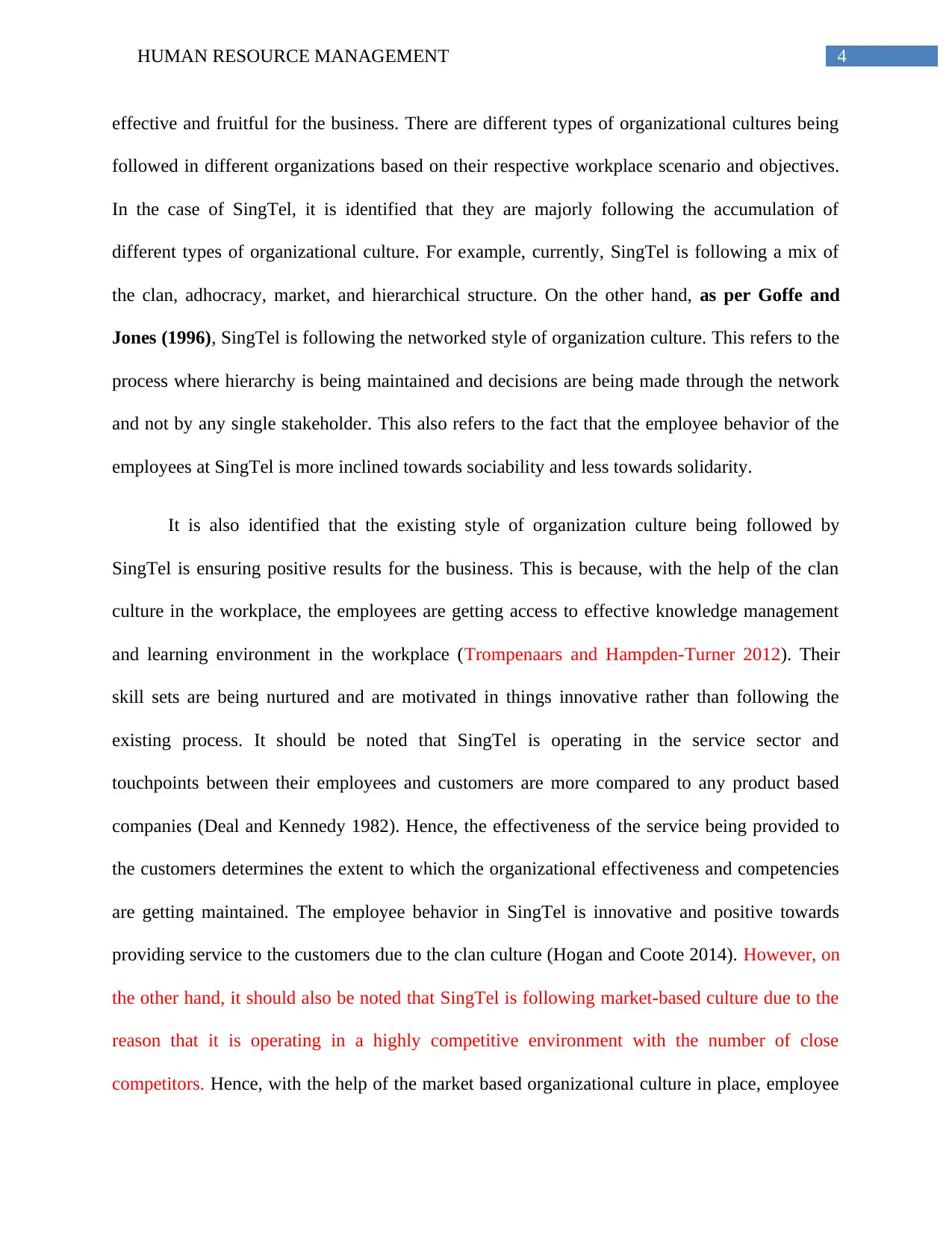
4HUMAN RESOURCE MANAGEMENT
effective and fruitful for the business. There are different types of organizational cultures being
followed in different organizations based on their respective workplace scenario and objectives.
In the case of SingTel, it is identified that they are majorly following the accumulation of
different types of organizational culture. For example, currently, SingTel is following a mix of
the clan, adhocracy, market, and hierarchical structure. On the other hand, as per Goffe and
Jones (1996), SingTel is following the networked style of organization culture. This refers to the
process where hierarchy is being maintained and decisions are being made through the network
and not by any single stakeholder. This also refers to the fact that the employee behavior of the
employees at SingTel is more inclined towards sociability and less towards solidarity.
It is also identified that the existing style of organization culture being followed by
SingTel is ensuring positive results for the business. This is because, with the help of the clan
culture in the workplace, the employees are getting access to effective knowledge management
and learning environment in the workplace (Trompenaars and Hampden-Turner 2012). Their
skill sets are being nurtured and are motivated in things innovative rather than following the
existing process. It should be noted that SingTel is operating in the service sector and
touchpoints between their employees and customers are more compared to any product based
companies (Deal and Kennedy 1982). Hence, the effectiveness of the service being provided to
the customers determines the extent to which the organizational effectiveness and competencies
are getting maintained. The employee behavior in SingTel is innovative and positive towards
providing service to the customers due to the clan culture (Hogan and Coote 2014). However, on
the other hand, it should also be noted that SingTel is following market-based culture due to the
reason that it is operating in a highly competitive environment with the number of close
competitors. Hence, with the help of the market based organizational culture in place, employee
effective and fruitful for the business. There are different types of organizational cultures being
followed in different organizations based on their respective workplace scenario and objectives.
In the case of SingTel, it is identified that they are majorly following the accumulation of
different types of organizational culture. For example, currently, SingTel is following a mix of
the clan, adhocracy, market, and hierarchical structure. On the other hand, as per Goffe and
Jones (1996), SingTel is following the networked style of organization culture. This refers to the
process where hierarchy is being maintained and decisions are being made through the network
and not by any single stakeholder. This also refers to the fact that the employee behavior of the
employees at SingTel is more inclined towards sociability and less towards solidarity.
It is also identified that the existing style of organization culture being followed by
SingTel is ensuring positive results for the business. This is because, with the help of the clan
culture in the workplace, the employees are getting access to effective knowledge management
and learning environment in the workplace (Trompenaars and Hampden-Turner 2012). Their
skill sets are being nurtured and are motivated in things innovative rather than following the
existing process. It should be noted that SingTel is operating in the service sector and
touchpoints between their employees and customers are more compared to any product based
companies (Deal and Kennedy 1982). Hence, the effectiveness of the service being provided to
the customers determines the extent to which the organizational effectiveness and competencies
are getting maintained. The employee behavior in SingTel is innovative and positive towards
providing service to the customers due to the clan culture (Hogan and Coote 2014). However, on
the other hand, it should also be noted that SingTel is following market-based culture due to the
reason that it is operating in a highly competitive environment with the number of close
competitors. Hence, with the help of the market based organizational culture in place, employee
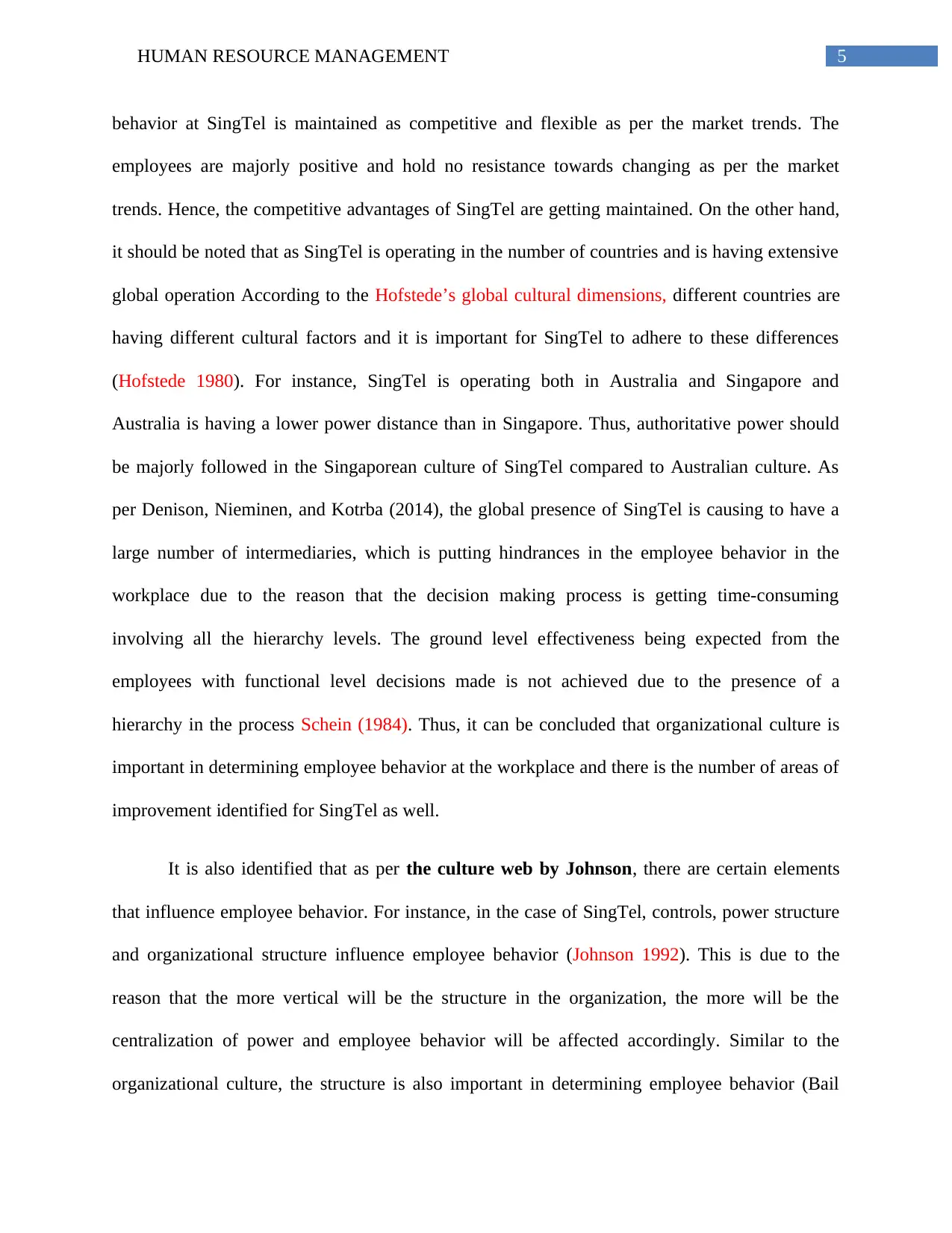
5HUMAN RESOURCE MANAGEMENT
behavior at SingTel is maintained as competitive and flexible as per the market trends. The
employees are majorly positive and hold no resistance towards changing as per the market
trends. Hence, the competitive advantages of SingTel are getting maintained. On the other hand,
it should be noted that as SingTel is operating in the number of countries and is having extensive
global operation According to the Hofstede’s global cultural dimensions, different countries are
having different cultural factors and it is important for SingTel to adhere to these differences
(Hofstede 1980). For instance, SingTel is operating both in Australia and Singapore and
Australia is having a lower power distance than in Singapore. Thus, authoritative power should
be majorly followed in the Singaporean culture of SingTel compared to Australian culture. As
per Denison, Nieminen, and Kotrba (2014), the global presence of SingTel is causing to have a
large number of intermediaries, which is putting hindrances in the employee behavior in the
workplace due to the reason that the decision making process is getting time-consuming
involving all the hierarchy levels. The ground level effectiveness being expected from the
employees with functional level decisions made is not achieved due to the presence of a
hierarchy in the process Schein (1984). Thus, it can be concluded that organizational culture is
important in determining employee behavior at the workplace and there is the number of areas of
improvement identified for SingTel as well.
It is also identified that as per the culture web by Johnson, there are certain elements
that influence employee behavior. For instance, in the case of SingTel, controls, power structure
and organizational structure influence employee behavior (Johnson 1992). This is due to the
reason that the more vertical will be the structure in the organization, the more will be the
centralization of power and employee behavior will be affected accordingly. Similar to the
organizational culture, the structure is also important in determining employee behavior (Bail
behavior at SingTel is maintained as competitive and flexible as per the market trends. The
employees are majorly positive and hold no resistance towards changing as per the market
trends. Hence, the competitive advantages of SingTel are getting maintained. On the other hand,
it should be noted that as SingTel is operating in the number of countries and is having extensive
global operation According to the Hofstede’s global cultural dimensions, different countries are
having different cultural factors and it is important for SingTel to adhere to these differences
(Hofstede 1980). For instance, SingTel is operating both in Australia and Singapore and
Australia is having a lower power distance than in Singapore. Thus, authoritative power should
be majorly followed in the Singaporean culture of SingTel compared to Australian culture. As
per Denison, Nieminen, and Kotrba (2014), the global presence of SingTel is causing to have a
large number of intermediaries, which is putting hindrances in the employee behavior in the
workplace due to the reason that the decision making process is getting time-consuming
involving all the hierarchy levels. The ground level effectiveness being expected from the
employees with functional level decisions made is not achieved due to the presence of a
hierarchy in the process Schein (1984). Thus, it can be concluded that organizational culture is
important in determining employee behavior at the workplace and there is the number of areas of
improvement identified for SingTel as well.
It is also identified that as per the culture web by Johnson, there are certain elements
that influence employee behavior. For instance, in the case of SingTel, controls, power structure
and organizational structure influence employee behavior (Johnson 1992). This is due to the
reason that the more vertical will be the structure in the organization, the more will be the
centralization of power and employee behavior will be affected accordingly. Similar to the
organizational culture, the structure is also important in determining employee behavior (Bail
⊘ This is a preview!⊘
Do you want full access?
Subscribe today to unlock all pages.

Trusted by 1+ million students worldwide
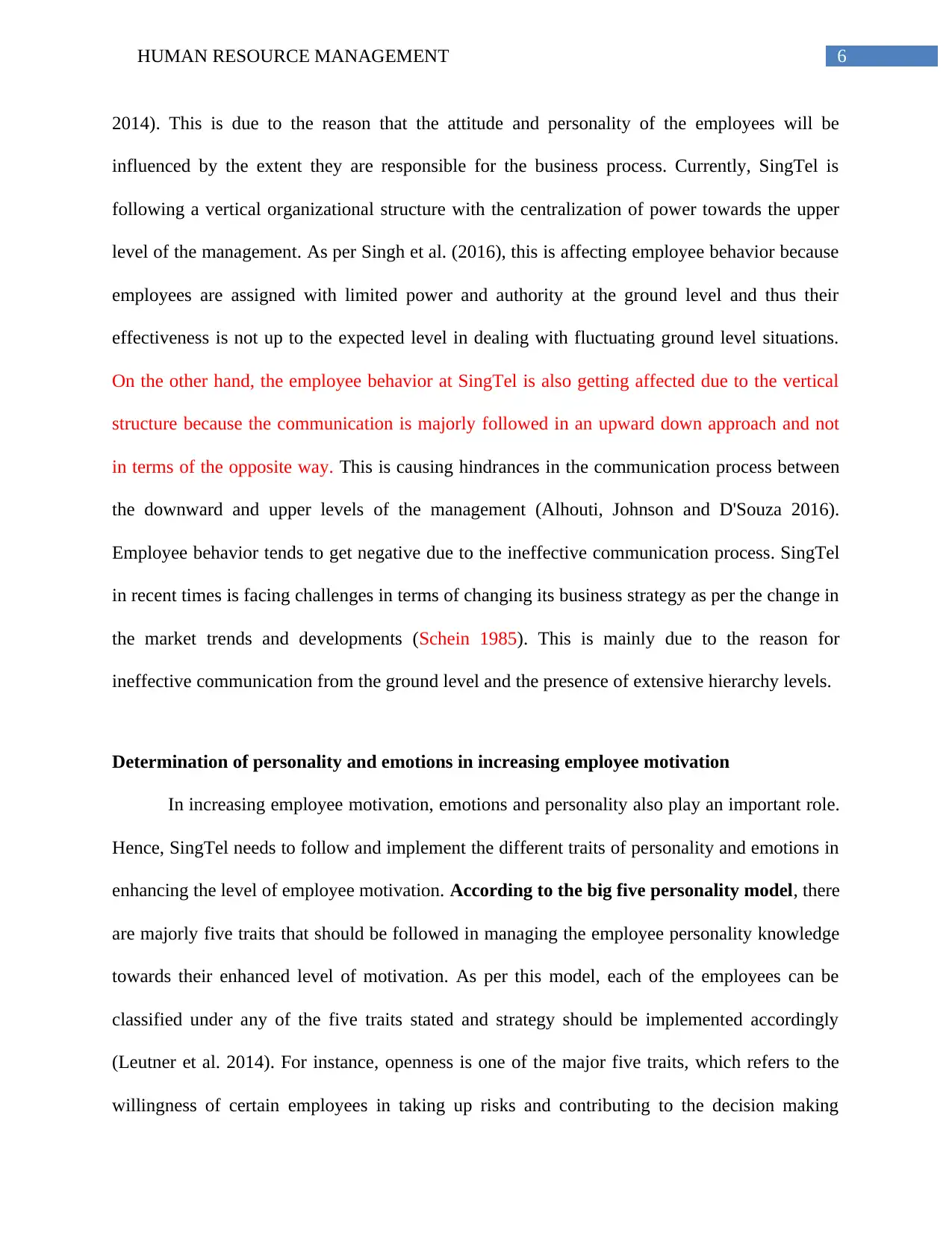
6HUMAN RESOURCE MANAGEMENT
2014). This is due to the reason that the attitude and personality of the employees will be
influenced by the extent they are responsible for the business process. Currently, SingTel is
following a vertical organizational structure with the centralization of power towards the upper
level of the management. As per Singh et al. (2016), this is affecting employee behavior because
employees are assigned with limited power and authority at the ground level and thus their
effectiveness is not up to the expected level in dealing with fluctuating ground level situations.
On the other hand, the employee behavior at SingTel is also getting affected due to the vertical
structure because the communication is majorly followed in an upward down approach and not
in terms of the opposite way. This is causing hindrances in the communication process between
the downward and upper levels of the management (Alhouti, Johnson and D'Souza 2016).
Employee behavior tends to get negative due to the ineffective communication process. SingTel
in recent times is facing challenges in terms of changing its business strategy as per the change in
the market trends and developments (Schein 1985). This is mainly due to the reason for
ineffective communication from the ground level and the presence of extensive hierarchy levels.
Determination of personality and emotions in increasing employee motivation
In increasing employee motivation, emotions and personality also play an important role.
Hence, SingTel needs to follow and implement the different traits of personality and emotions in
enhancing the level of employee motivation. According to the big five personality model, there
are majorly five traits that should be followed in managing the employee personality knowledge
towards their enhanced level of motivation. As per this model, each of the employees can be
classified under any of the five traits stated and strategy should be implemented accordingly
(Leutner et al. 2014). For instance, openness is one of the major five traits, which refers to the
willingness of certain employees in taking up risks and contributing to the decision making
2014). This is due to the reason that the attitude and personality of the employees will be
influenced by the extent they are responsible for the business process. Currently, SingTel is
following a vertical organizational structure with the centralization of power towards the upper
level of the management. As per Singh et al. (2016), this is affecting employee behavior because
employees are assigned with limited power and authority at the ground level and thus their
effectiveness is not up to the expected level in dealing with fluctuating ground level situations.
On the other hand, the employee behavior at SingTel is also getting affected due to the vertical
structure because the communication is majorly followed in an upward down approach and not
in terms of the opposite way. This is causing hindrances in the communication process between
the downward and upper levels of the management (Alhouti, Johnson and D'Souza 2016).
Employee behavior tends to get negative due to the ineffective communication process. SingTel
in recent times is facing challenges in terms of changing its business strategy as per the change in
the market trends and developments (Schein 1985). This is mainly due to the reason for
ineffective communication from the ground level and the presence of extensive hierarchy levels.
Determination of personality and emotions in increasing employee motivation
In increasing employee motivation, emotions and personality also play an important role.
Hence, SingTel needs to follow and implement the different traits of personality and emotions in
enhancing the level of employee motivation. According to the big five personality model, there
are majorly five traits that should be followed in managing the employee personality knowledge
towards their enhanced level of motivation. As per this model, each of the employees can be
classified under any of the five traits stated and strategy should be implemented accordingly
(Leutner et al. 2014). For instance, openness is one of the major five traits, which refers to the
willingness of certain employees in taking up risks and contributing to the decision making
Paraphrase This Document
Need a fresh take? Get an instant paraphrase of this document with our AI Paraphraser
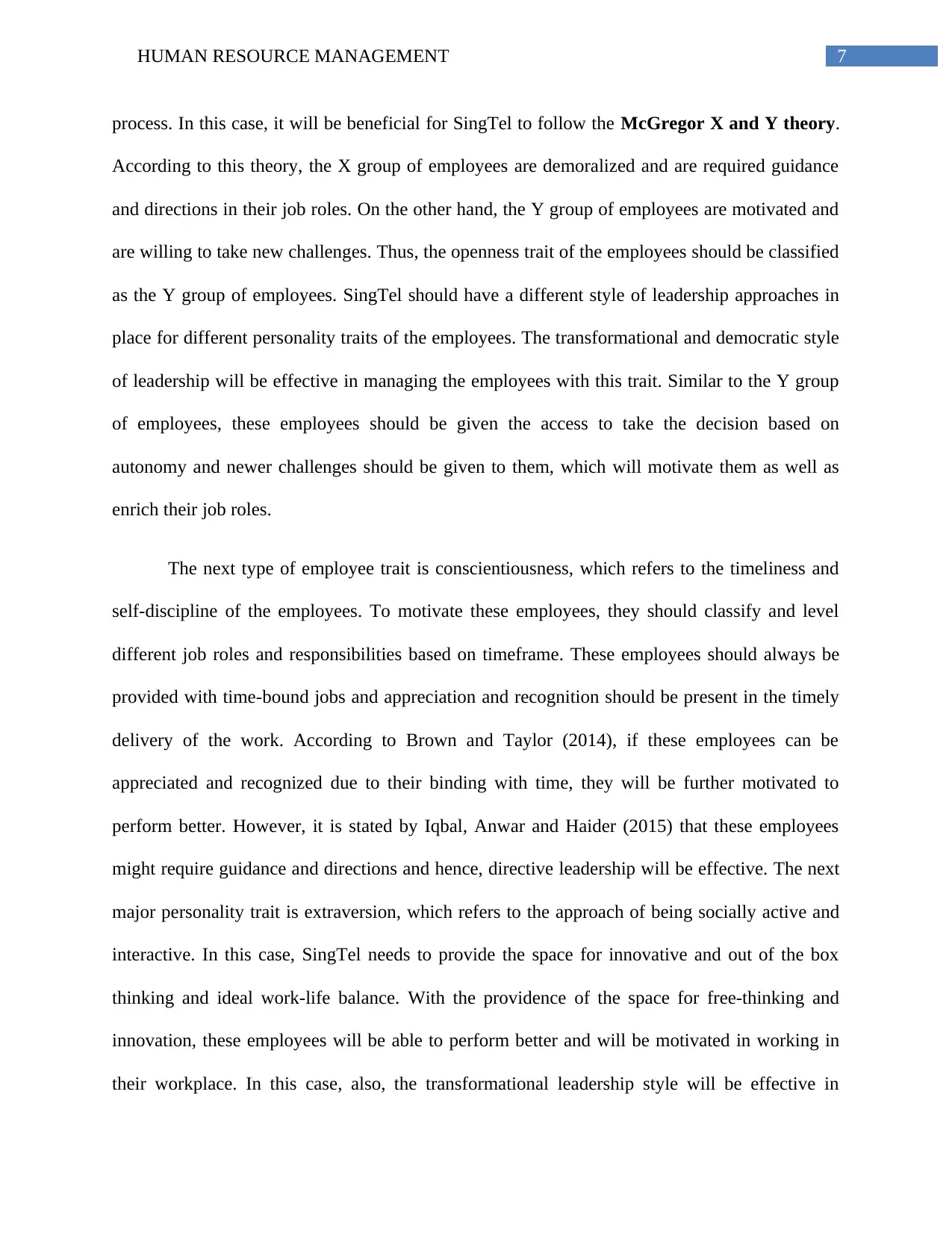
7HUMAN RESOURCE MANAGEMENT
process. In this case, it will be beneficial for SingTel to follow the McGregor X and Y theory.
According to this theory, the X group of employees are demoralized and are required guidance
and directions in their job roles. On the other hand, the Y group of employees are motivated and
are willing to take new challenges. Thus, the openness trait of the employees should be classified
as the Y group of employees. SingTel should have a different style of leadership approaches in
place for different personality traits of the employees. The transformational and democratic style
of leadership will be effective in managing the employees with this trait. Similar to the Y group
of employees, these employees should be given the access to take the decision based on
autonomy and newer challenges should be given to them, which will motivate them as well as
enrich their job roles.
The next type of employee trait is conscientiousness, which refers to the timeliness and
self-discipline of the employees. To motivate these employees, they should classify and level
different job roles and responsibilities based on timeframe. These employees should always be
provided with time-bound jobs and appreciation and recognition should be present in the timely
delivery of the work. According to Brown and Taylor (2014), if these employees can be
appreciated and recognized due to their binding with time, they will be further motivated to
perform better. However, it is stated by Iqbal, Anwar and Haider (2015) that these employees
might require guidance and directions and hence, directive leadership will be effective. The next
major personality trait is extraversion, which refers to the approach of being socially active and
interactive. In this case, SingTel needs to provide the space for innovative and out of the box
thinking and ideal work-life balance. With the providence of the space for free-thinking and
innovation, these employees will be able to perform better and will be motivated in working in
their workplace. In this case, also, the transformational leadership style will be effective in
process. In this case, it will be beneficial for SingTel to follow the McGregor X and Y theory.
According to this theory, the X group of employees are demoralized and are required guidance
and directions in their job roles. On the other hand, the Y group of employees are motivated and
are willing to take new challenges. Thus, the openness trait of the employees should be classified
as the Y group of employees. SingTel should have a different style of leadership approaches in
place for different personality traits of the employees. The transformational and democratic style
of leadership will be effective in managing the employees with this trait. Similar to the Y group
of employees, these employees should be given the access to take the decision based on
autonomy and newer challenges should be given to them, which will motivate them as well as
enrich their job roles.
The next type of employee trait is conscientiousness, which refers to the timeliness and
self-discipline of the employees. To motivate these employees, they should classify and level
different job roles and responsibilities based on timeframe. These employees should always be
provided with time-bound jobs and appreciation and recognition should be present in the timely
delivery of the work. According to Brown and Taylor (2014), if these employees can be
appreciated and recognized due to their binding with time, they will be further motivated to
perform better. However, it is stated by Iqbal, Anwar and Haider (2015) that these employees
might require guidance and directions and hence, directive leadership will be effective. The next
major personality trait is extraversion, which refers to the approach of being socially active and
interactive. In this case, SingTel needs to provide the space for innovative and out of the box
thinking and ideal work-life balance. With the providence of the space for free-thinking and
innovation, these employees will be able to perform better and will be motivated in working in
their workplace. In this case, also, the transformational leadership style will be effective in
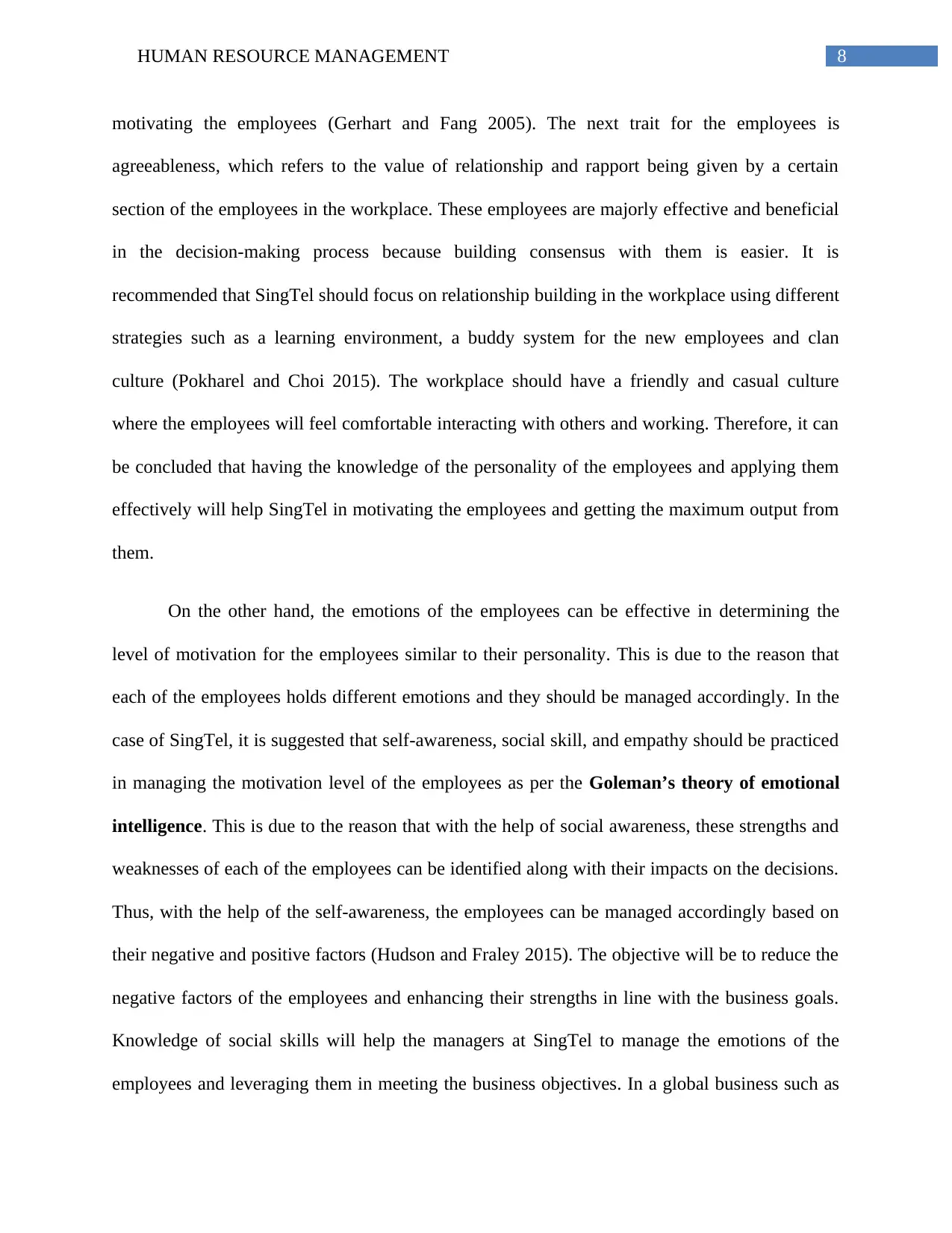
8HUMAN RESOURCE MANAGEMENT
motivating the employees (Gerhart and Fang 2005). The next trait for the employees is
agreeableness, which refers to the value of relationship and rapport being given by a certain
section of the employees in the workplace. These employees are majorly effective and beneficial
in the decision-making process because building consensus with them is easier. It is
recommended that SingTel should focus on relationship building in the workplace using different
strategies such as a learning environment, a buddy system for the new employees and clan
culture (Pokharel and Choi 2015). The workplace should have a friendly and casual culture
where the employees will feel comfortable interacting with others and working. Therefore, it can
be concluded that having the knowledge of the personality of the employees and applying them
effectively will help SingTel in motivating the employees and getting the maximum output from
them.
On the other hand, the emotions of the employees can be effective in determining the
level of motivation for the employees similar to their personality. This is due to the reason that
each of the employees holds different emotions and they should be managed accordingly. In the
case of SingTel, it is suggested that self-awareness, social skill, and empathy should be practiced
in managing the motivation level of the employees as per the Goleman’s theory of emotional
intelligence. This is due to the reason that with the help of social awareness, these strengths and
weaknesses of each of the employees can be identified along with their impacts on the decisions.
Thus, with the help of the self-awareness, the employees can be managed accordingly based on
their negative and positive factors (Hudson and Fraley 2015). The objective will be to reduce the
negative factors of the employees and enhancing their strengths in line with the business goals.
Knowledge of social skills will help the managers at SingTel to manage the emotions of the
employees and leveraging them in meeting the business objectives. In a global business such as
motivating the employees (Gerhart and Fang 2005). The next trait for the employees is
agreeableness, which refers to the value of relationship and rapport being given by a certain
section of the employees in the workplace. These employees are majorly effective and beneficial
in the decision-making process because building consensus with them is easier. It is
recommended that SingTel should focus on relationship building in the workplace using different
strategies such as a learning environment, a buddy system for the new employees and clan
culture (Pokharel and Choi 2015). The workplace should have a friendly and casual culture
where the employees will feel comfortable interacting with others and working. Therefore, it can
be concluded that having the knowledge of the personality of the employees and applying them
effectively will help SingTel in motivating the employees and getting the maximum output from
them.
On the other hand, the emotions of the employees can be effective in determining the
level of motivation for the employees similar to their personality. This is due to the reason that
each of the employees holds different emotions and they should be managed accordingly. In the
case of SingTel, it is suggested that self-awareness, social skill, and empathy should be practiced
in managing the motivation level of the employees as per the Goleman’s theory of emotional
intelligence. This is due to the reason that with the help of social awareness, these strengths and
weaknesses of each of the employees can be identified along with their impacts on the decisions.
Thus, with the help of the self-awareness, the employees can be managed accordingly based on
their negative and positive factors (Hudson and Fraley 2015). The objective will be to reduce the
negative factors of the employees and enhancing their strengths in line with the business goals.
Knowledge of social skills will help the managers at SingTel to manage the emotions of the
employees and leveraging them in meeting the business objectives. In a global business such as
⊘ This is a preview!⊘
Do you want full access?
Subscribe today to unlock all pages.

Trusted by 1+ million students worldwide
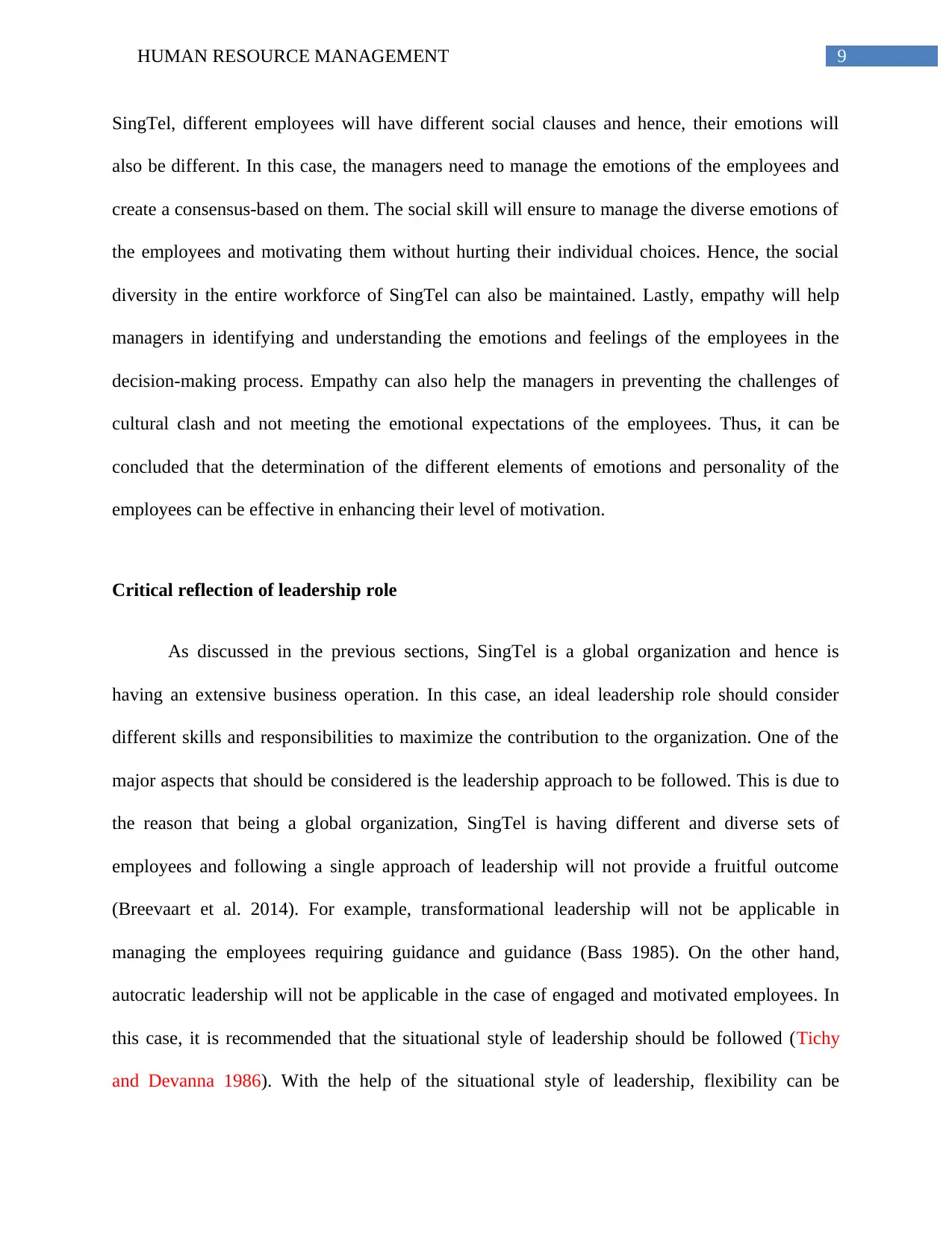
9HUMAN RESOURCE MANAGEMENT
SingTel, different employees will have different social clauses and hence, their emotions will
also be different. In this case, the managers need to manage the emotions of the employees and
create a consensus-based on them. The social skill will ensure to manage the diverse emotions of
the employees and motivating them without hurting their individual choices. Hence, the social
diversity in the entire workforce of SingTel can also be maintained. Lastly, empathy will help
managers in identifying and understanding the emotions and feelings of the employees in the
decision-making process. Empathy can also help the managers in preventing the challenges of
cultural clash and not meeting the emotional expectations of the employees. Thus, it can be
concluded that the determination of the different elements of emotions and personality of the
employees can be effective in enhancing their level of motivation.
Critical reflection of leadership role
As discussed in the previous sections, SingTel is a global organization and hence is
having an extensive business operation. In this case, an ideal leadership role should consider
different skills and responsibilities to maximize the contribution to the organization. One of the
major aspects that should be considered is the leadership approach to be followed. This is due to
the reason that being a global organization, SingTel is having different and diverse sets of
employees and following a single approach of leadership will not provide a fruitful outcome
(Breevaart et al. 2014). For example, transformational leadership will not be applicable in
managing the employees requiring guidance and guidance (Bass 1985). On the other hand,
autocratic leadership will not be applicable in the case of engaged and motivated employees. In
this case, it is recommended that the situational style of leadership should be followed (Tichy
and Devanna 1986). With the help of the situational style of leadership, flexibility can be
SingTel, different employees will have different social clauses and hence, their emotions will
also be different. In this case, the managers need to manage the emotions of the employees and
create a consensus-based on them. The social skill will ensure to manage the diverse emotions of
the employees and motivating them without hurting their individual choices. Hence, the social
diversity in the entire workforce of SingTel can also be maintained. Lastly, empathy will help
managers in identifying and understanding the emotions and feelings of the employees in the
decision-making process. Empathy can also help the managers in preventing the challenges of
cultural clash and not meeting the emotional expectations of the employees. Thus, it can be
concluded that the determination of the different elements of emotions and personality of the
employees can be effective in enhancing their level of motivation.
Critical reflection of leadership role
As discussed in the previous sections, SingTel is a global organization and hence is
having an extensive business operation. In this case, an ideal leadership role should consider
different skills and responsibilities to maximize the contribution to the organization. One of the
major aspects that should be considered is the leadership approach to be followed. This is due to
the reason that being a global organization, SingTel is having different and diverse sets of
employees and following a single approach of leadership will not provide a fruitful outcome
(Breevaart et al. 2014). For example, transformational leadership will not be applicable in
managing the employees requiring guidance and guidance (Bass 1985). On the other hand,
autocratic leadership will not be applicable in the case of engaged and motivated employees. In
this case, it is recommended that the situational style of leadership should be followed (Tichy
and Devanna 1986). With the help of the situational style of leadership, flexibility can be
Paraphrase This Document
Need a fresh take? Get an instant paraphrase of this document with our AI Paraphraser
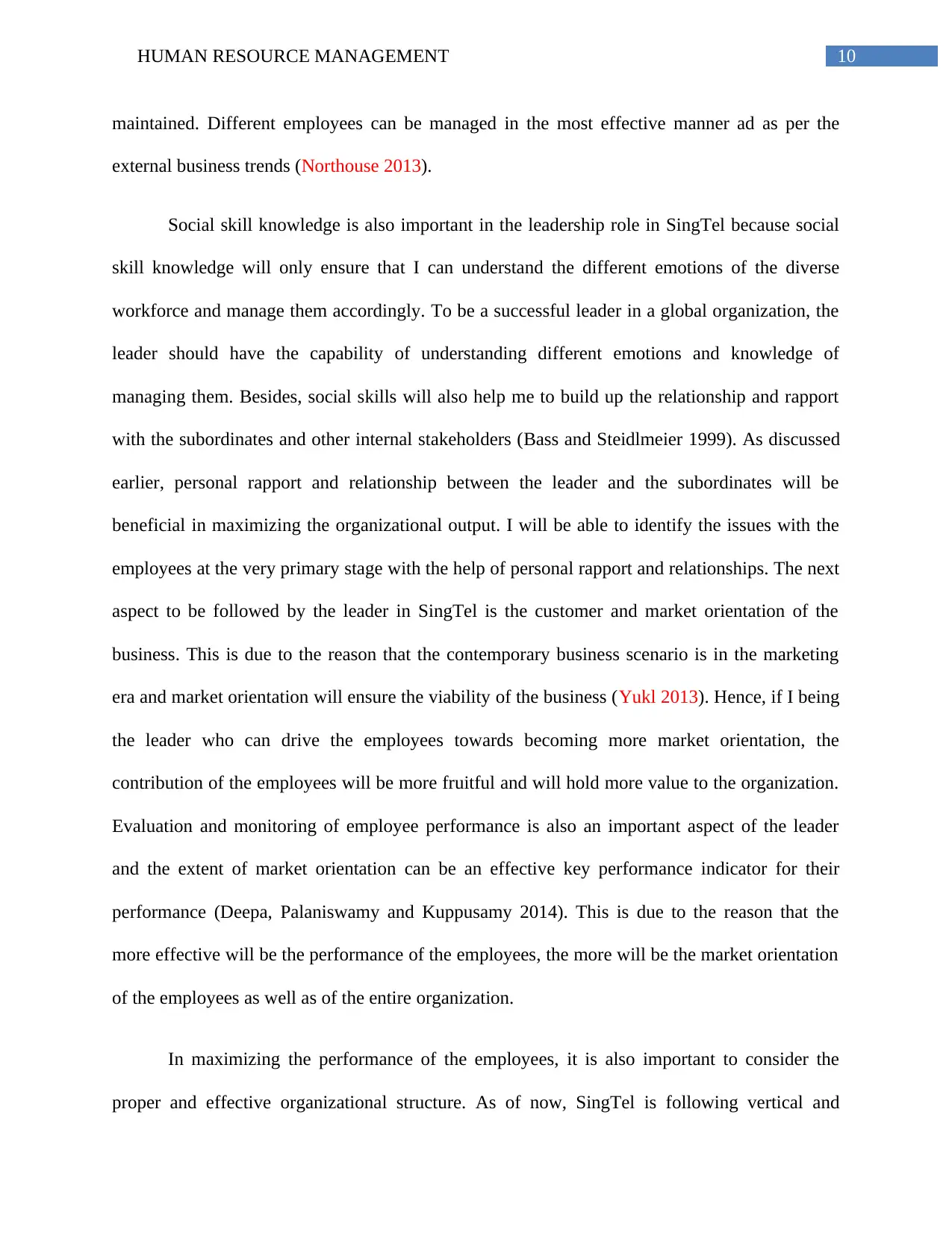
10HUMAN RESOURCE MANAGEMENT
maintained. Different employees can be managed in the most effective manner ad as per the
external business trends (Northouse 2013).
Social skill knowledge is also important in the leadership role in SingTel because social
skill knowledge will only ensure that I can understand the different emotions of the diverse
workforce and manage them accordingly. To be a successful leader in a global organization, the
leader should have the capability of understanding different emotions and knowledge of
managing them. Besides, social skills will also help me to build up the relationship and rapport
with the subordinates and other internal stakeholders (Bass and Steidlmeier 1999). As discussed
earlier, personal rapport and relationship between the leader and the subordinates will be
beneficial in maximizing the organizational output. I will be able to identify the issues with the
employees at the very primary stage with the help of personal rapport and relationships. The next
aspect to be followed by the leader in SingTel is the customer and market orientation of the
business. This is due to the reason that the contemporary business scenario is in the marketing
era and market orientation will ensure the viability of the business (Yukl 2013). Hence, if I being
the leader who can drive the employees towards becoming more market orientation, the
contribution of the employees will be more fruitful and will hold more value to the organization.
Evaluation and monitoring of employee performance is also an important aspect of the leader
and the extent of market orientation can be an effective key performance indicator for their
performance (Deepa, Palaniswamy and Kuppusamy 2014). This is due to the reason that the
more effective will be the performance of the employees, the more will be the market orientation
of the employees as well as of the entire organization.
In maximizing the performance of the employees, it is also important to consider the
proper and effective organizational structure. As of now, SingTel is following vertical and
maintained. Different employees can be managed in the most effective manner ad as per the
external business trends (Northouse 2013).
Social skill knowledge is also important in the leadership role in SingTel because social
skill knowledge will only ensure that I can understand the different emotions of the diverse
workforce and manage them accordingly. To be a successful leader in a global organization, the
leader should have the capability of understanding different emotions and knowledge of
managing them. Besides, social skills will also help me to build up the relationship and rapport
with the subordinates and other internal stakeholders (Bass and Steidlmeier 1999). As discussed
earlier, personal rapport and relationship between the leader and the subordinates will be
beneficial in maximizing the organizational output. I will be able to identify the issues with the
employees at the very primary stage with the help of personal rapport and relationships. The next
aspect to be followed by the leader in SingTel is the customer and market orientation of the
business. This is due to the reason that the contemporary business scenario is in the marketing
era and market orientation will ensure the viability of the business (Yukl 2013). Hence, if I being
the leader who can drive the employees towards becoming more market orientation, the
contribution of the employees will be more fruitful and will hold more value to the organization.
Evaluation and monitoring of employee performance is also an important aspect of the leader
and the extent of market orientation can be an effective key performance indicator for their
performance (Deepa, Palaniswamy and Kuppusamy 2014). This is due to the reason that the
more effective will be the performance of the employees, the more will be the market orientation
of the employees as well as of the entire organization.
In maximizing the performance of the employees, it is also important to consider the
proper and effective organizational structure. As of now, SingTel is following vertical and
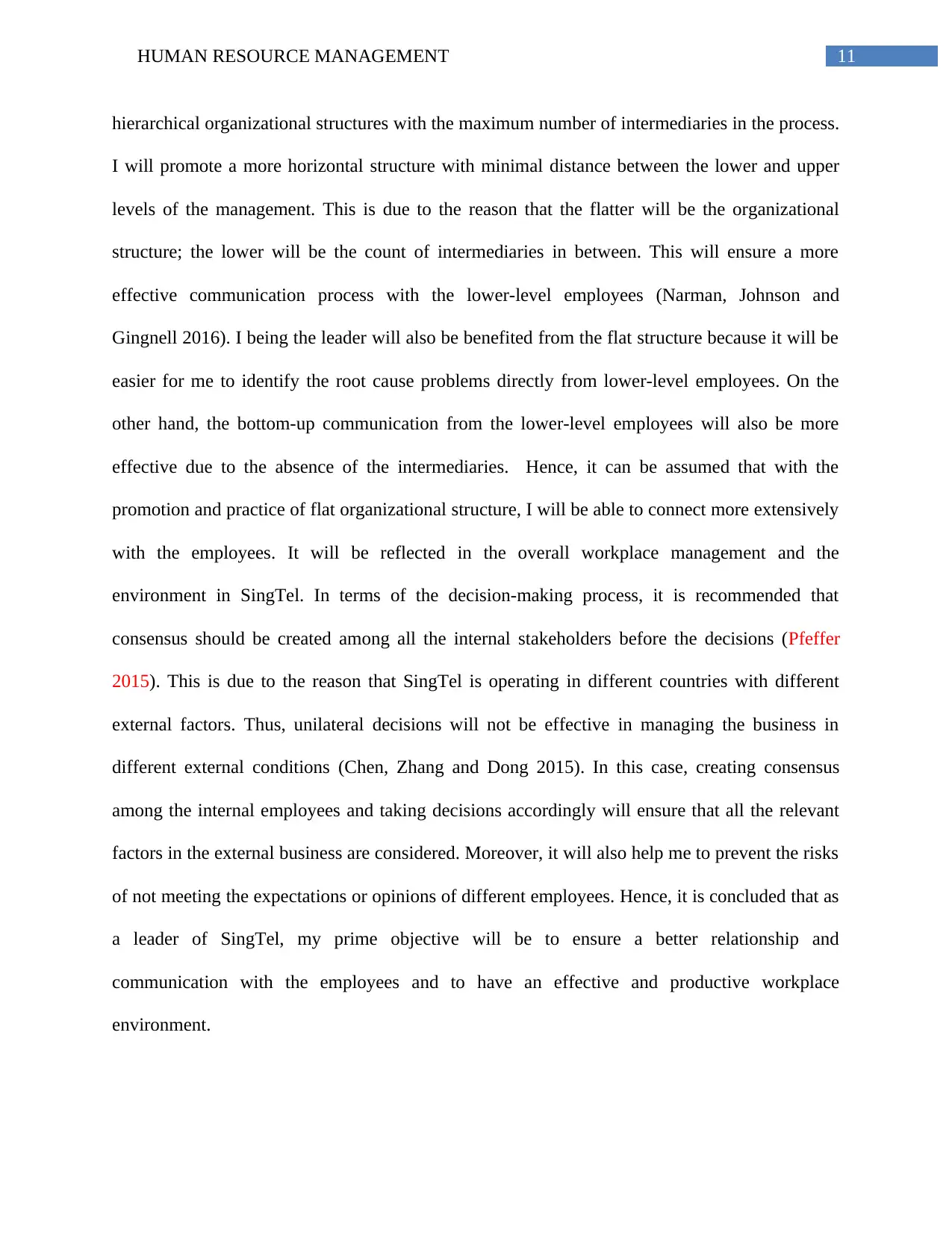
11HUMAN RESOURCE MANAGEMENT
hierarchical organizational structures with the maximum number of intermediaries in the process.
I will promote a more horizontal structure with minimal distance between the lower and upper
levels of the management. This is due to the reason that the flatter will be the organizational
structure; the lower will be the count of intermediaries in between. This will ensure a more
effective communication process with the lower-level employees (Narman, Johnson and
Gingnell 2016). I being the leader will also be benefited from the flat structure because it will be
easier for me to identify the root cause problems directly from lower-level employees. On the
other hand, the bottom-up communication from the lower-level employees will also be more
effective due to the absence of the intermediaries. Hence, it can be assumed that with the
promotion and practice of flat organizational structure, I will be able to connect more extensively
with the employees. It will be reflected in the overall workplace management and the
environment in SingTel. In terms of the decision-making process, it is recommended that
consensus should be created among all the internal stakeholders before the decisions (Pfeffer
2015). This is due to the reason that SingTel is operating in different countries with different
external factors. Thus, unilateral decisions will not be effective in managing the business in
different external conditions (Chen, Zhang and Dong 2015). In this case, creating consensus
among the internal employees and taking decisions accordingly will ensure that all the relevant
factors in the external business are considered. Moreover, it will also help me to prevent the risks
of not meeting the expectations or opinions of different employees. Hence, it is concluded that as
a leader of SingTel, my prime objective will be to ensure a better relationship and
communication with the employees and to have an effective and productive workplace
environment.
hierarchical organizational structures with the maximum number of intermediaries in the process.
I will promote a more horizontal structure with minimal distance between the lower and upper
levels of the management. This is due to the reason that the flatter will be the organizational
structure; the lower will be the count of intermediaries in between. This will ensure a more
effective communication process with the lower-level employees (Narman, Johnson and
Gingnell 2016). I being the leader will also be benefited from the flat structure because it will be
easier for me to identify the root cause problems directly from lower-level employees. On the
other hand, the bottom-up communication from the lower-level employees will also be more
effective due to the absence of the intermediaries. Hence, it can be assumed that with the
promotion and practice of flat organizational structure, I will be able to connect more extensively
with the employees. It will be reflected in the overall workplace management and the
environment in SingTel. In terms of the decision-making process, it is recommended that
consensus should be created among all the internal stakeholders before the decisions (Pfeffer
2015). This is due to the reason that SingTel is operating in different countries with different
external factors. Thus, unilateral decisions will not be effective in managing the business in
different external conditions (Chen, Zhang and Dong 2015). In this case, creating consensus
among the internal employees and taking decisions accordingly will ensure that all the relevant
factors in the external business are considered. Moreover, it will also help me to prevent the risks
of not meeting the expectations or opinions of different employees. Hence, it is concluded that as
a leader of SingTel, my prime objective will be to ensure a better relationship and
communication with the employees and to have an effective and productive workplace
environment.
⊘ This is a preview!⊘
Do you want full access?
Subscribe today to unlock all pages.

Trusted by 1+ million students worldwide
1 out of 17
Related Documents
Your All-in-One AI-Powered Toolkit for Academic Success.
+13062052269
info@desklib.com
Available 24*7 on WhatsApp / Email
![[object Object]](/_next/static/media/star-bottom.7253800d.svg)
Unlock your academic potential
Copyright © 2020–2025 A2Z Services. All Rights Reserved. Developed and managed by ZUCOL.





